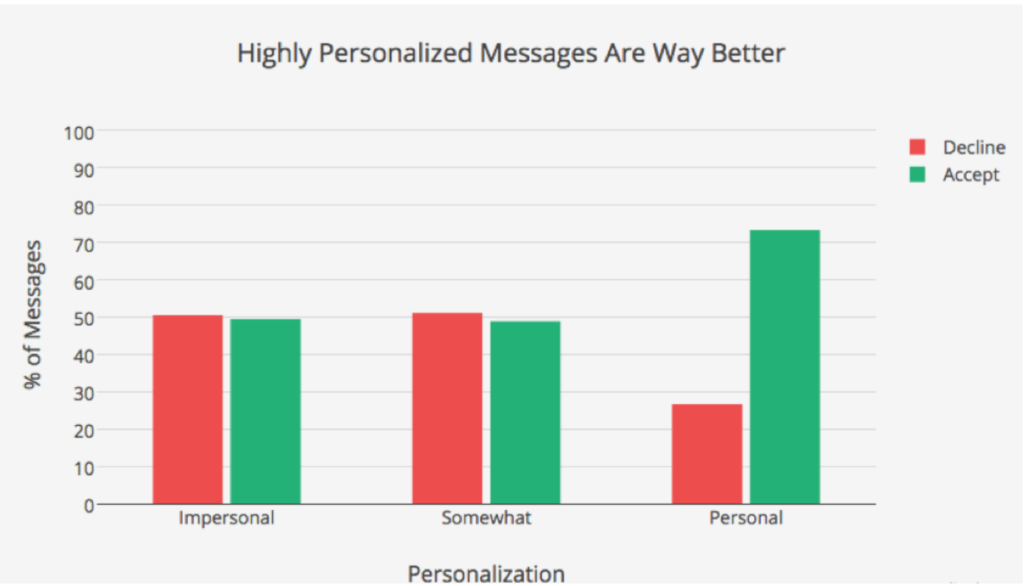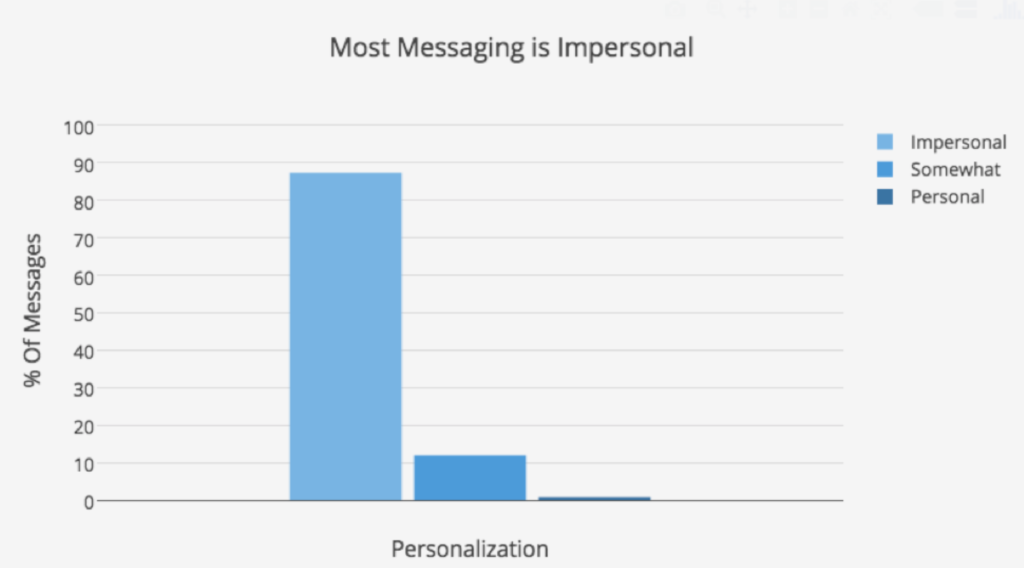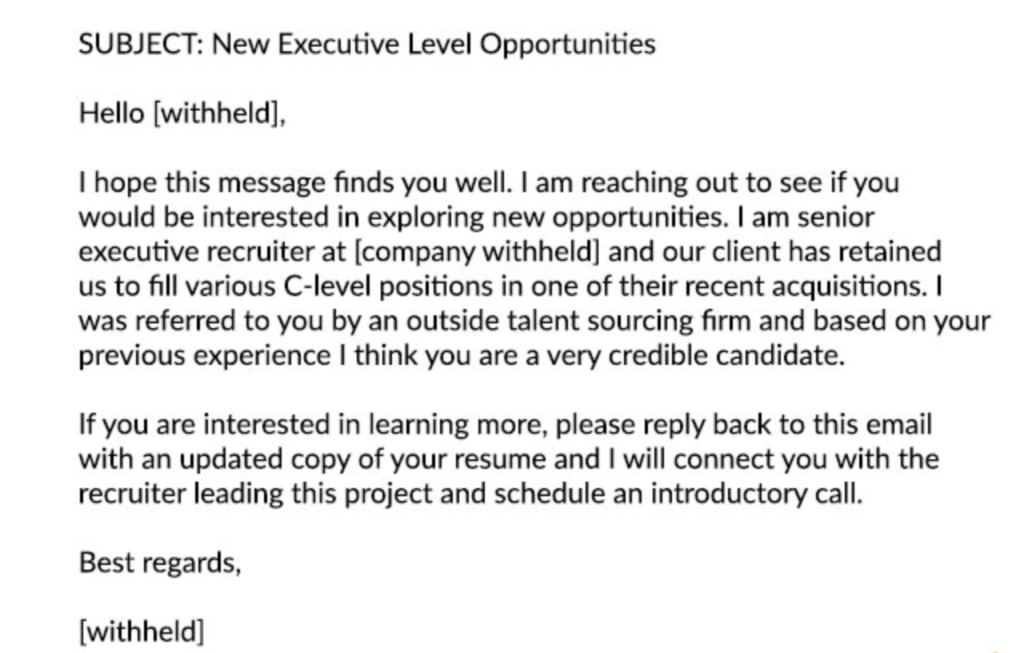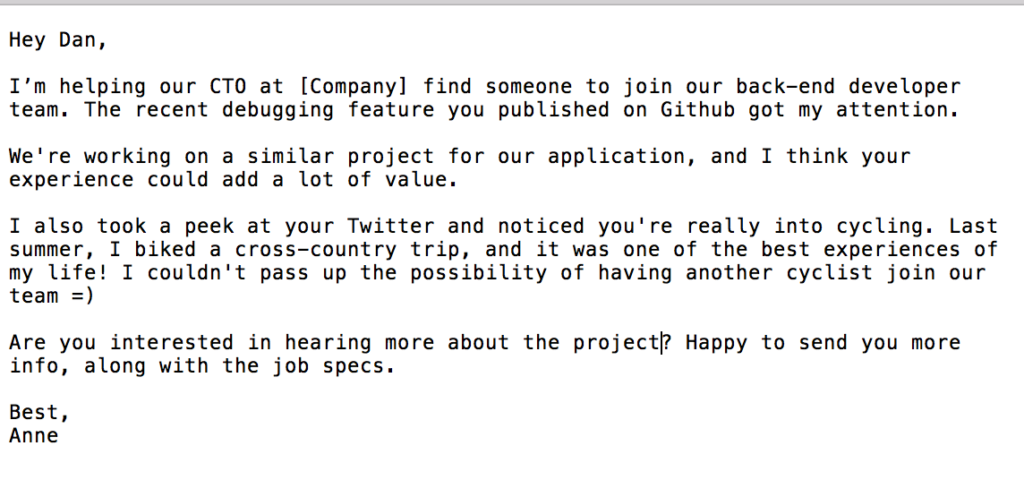
Did you know the majority of developers are early-risers?
That’s just one of the interesting facts we learned while reviewing Stack Overflow’s 2018 Developer Hiring Survey.
Read More

That’s just one of the interesting facts we learned while reviewing Stack Overflow’s 2018 Developer Hiring Survey.
Read More

We’ve come a long way since 1989.
That was the year recruiters began using fax machines in the workplace.
Remember those?
We still can’t believe Dylan pawned his guitar to keep his fax machine on 90210.
We also find it hard to believe that old-school recruiters heavily relied on the archaic machines to communicate with candidates.
Compare that to the modern recruiter, who spends a significant portion of their day writing emails, and you have a very different job description. The modern recruiter almost exclusively utilizes the Internet for identifying candidates.
The most powerful tool in their toolbox? The cold email.
Exceptional email composition skills are especially important to tech recruiters whose desired candidates are often comfortably employed. With that said, just because someone can write a beautiful poem doesn’t mean they can write an effective cold email. The good news?
Positioning yourself within the top 5 percent of tech recruiters isn’t that difficult.
“I receive like five to 10 messages a week from recruiters,” says Simon on StackExchange. “I would say less than 5 percent even made the effort to read through my profile to check if I would be a good fit. I answer these messages, if I’m interested or not. The remaining 95 percent are just ignored.”
Based on Simon’s comment, doing the bare minimum of verifying skill compatibility on LinkedIn could catapult you ahead of competitors.
Visit an online developer forum, and you will find no shortage of conversations revolving around cold emails from “annoying tech recruiters.” Exactly what qualifies someone as an annoying tech recruiter?
Obviously, you don’t want to be the annoying recruiter developers loathe; you want to be the awesome recruiter who receives responses like this:

In this article, we’re going to provide flexible guidelines for cold emailing candidates. These suggestions may be applied to a variety of situations.
Let’s get started:

Did you know most programmers love to code? So much so, that they work on their own projects outside of work?
You might be surprised how many developers receive generic messages that covertly say: Hi, I know nothing about your skills, capabilities or interests. However, I think this is a great opportunity for you!
Not only does such carelessness make recruiters appear inconsiderate, but it also guarantees disengagement from the kind of talent you really want.
Before, writing your cold email, evaluate the candidate’s LinkedIn, GitHub, Twitter, online portfolio and any other relevant project information you can find.
Your goal is to identify:
Exactly how much does personalization matter when cold emailing a software engineer or developer?
In 2014, Hired analyzed a sample of approximately 8,000 recruiting messages with the intention of answering this question, among others. Factors assessed included company prestige and size, engineers’ desired salaries, degree of message personalization, and whether messages came from recruiters or from engineers/founders themselves.
According to the study, cold emails with a small amount of personalization barely received more recognition than those with none at all. However, those featuring a significant amount of personalized experienced a 73 percent response rate!

The study also found the majority of the 8,000 emails to be impersonal, with only 60 emails being genuinely personal.

The lesson? Find as many common ties as you can with someone you genuinely believe to be a good fit and emphasize those points in your pitch. And ask about those projects!
Do you read every email sent your way? No way.
When it comes to cold emails, the subject line is what stands between you and your candidate; it’s, the gatekeeper. That means it must invoke enough curiosity to get clicked.
What to Do:
What Not to Do:
The best cold emails are often the shortest. Why?
Everyone is busy, and most people are turned off by huge blocks of text from strangers.
Heather Morgan, cold email expert and founder of SalesFolk, recommends making your cold emails no longer than seven sentences; however, three to five sentences is ideal. The longer the email, the more personalization it should include.
Are you wondering how on earth you are supposed to keep your recruitment emails that short? Our best advice is to write like a human.
Imagine you run into your candidate at Starbucks — what would you say to them? Would you begin with how great your company is? Would you talk about yourself nonstop? Or would you say something like:
Hey Donna, I’m Dylan. I saw your SQL project on GitHub and was really fascinated with how you… I wanted to talk with you about my company because we’re trying to solve this problem about…?
Beginning the writing process with your “in-person scenario,” will make the final product sound more natural. When finished, go back and edit for brevity.

Wondering how on earth you are supposed to keep your recruitment cold emails so short? Eliminate those job requirements!
Again, you need developers more than they need you. Don’t ask a passive candidate to qualify themselves for a role by copying and pasting a list of requirements. Instead, provide a brief idea of the technologies involved. Save the details for later once interest has been established.
Again, the best candidates love to code — they are always open to hearing about new, exciting projects that will impact end-users.
While company gym memberships are great, developer candidates will probably be more interested in the kinds of projects they would be working on with your team.
As developer Mike A. told RecruitLoop contributor David Khim:
“My favorite recruiting email so far didn’t look like a recruiting email. It was just an invitation to chat about some GitHub project that the company works on. And the GitHub project was perfectly aligned with my interests.”
Talk with your IT manager before recruiting for any positions your unclear about. Make sure you broadly understand what the developer will be doing and how that will impact the big picture. Once you have this information, you can emphasize why that specific person might be the best person for the role.
A caveat: This tip might not work for everyone. If you don’t consider yourself funny, you might come across like you’re trying too hard to impress.
However, a dash of humor is often an effective way to stand out from the crowd and peek candidate interest. According to Yesware, humor is an effective way to revive MIA email chains. The organization achieved a 46 percent response rate by inserting humorous lines into abandoned email communications.
Courting a candidate who isn’t even in your ballpark is a waste of time. According to the StackOverflow Developer Hiring Survey 2018, compensation and benefits is the no. 1 priority of developers when evaluating job opportunities.

If an online marketer were advising you, they would recommend ending your cold emails with a clear Call-to-Action (CTA). Professional marketers don’t write a single piece of marketing collateral without one: Blog articles, Facebook advertisements, promotional emails and more all end with CTAs.
In this case, your CTA should include the next action you want the candidate to take if they are interested. What is the next step? Is it scheduling a conversation using your online calendar? Is it responding with any questions they may have about the role? Tell them exactly what to do next, and make it as relaxed as possible.
When is the last time you updated your company website? How about your personal LinkedIn profile? Are both pages accurately representing your company’s brand values, mission statement and products/services?
A candidate should be able to determine if they are a potential match from a cultural standpoint within a few seconds. Companies who have branded online presences that clearly communicate what they do will have an advantage when cold emailing candidates.
Obviously, you don’t need to wait for everything to be perfect. However, the less work a candidate has to do to figure out what you’re all about the better.

Finally, don’t forget to follow-up.
Heather Morgan, CEO and founder of SalesFolk, sends eight messages in every cold email campaign on behalf of her clients:
“Statistically speaking, you want to send eight emails to get a response. So that means seven follow ups. That’s because about 33 percent of your total (positive/neutral) responses will come from emails five through eight, so if you’re not sending eight, you’re missing out on leads.”
Why does it take some people so long to respond? They are either on the fence about making a decision or they are extremely busy. Also, different message approaches will resonate with different people. One thing Morgan cautions doing is sending the same follow-up email over and over again.
“Every email you send needs to add new and unique value, which gives you an opportunity to convince more people to have a conversation with you, since each email can focus on a different benefit,” says Morgan.
Clinton Buelter, founder of ColdEmailsforRecruiters, echoes this sentiment, saying he has experienced a huge bump in responses by simply following up with a personalized message.
“I learned to write short, custom follow up messages,” Buetler says. “That are read and receive a 50 percent or better response rate. I’ve also had good success with writing a new message to the candidate and referencing my previous message… By sending that second, third, fourth, ‘boomerang’ email, I was able to get my message read.”
They say: Practice makes perfect. But is that true when it comes to cold email writing? Probably, not.
You don’t need practice to sound like a human being. What you really need is unconditioning from sounding like a polite human resources robot. What do HR robots sound like?
Here’s an example of a bad cold email:

While the above email is polite, it’s extremely vague. It’s kinda hard to get excited about filling a “C-level position,” right? It also doesn’t hit upon any of our aforementioned steps, aside from brevity.
Unfortunately, this email is likely to receive no response. It provides zero personalization and no indication the recruiter reviewed the candidate’s skills, capabilities and projects.
Now, let’s look at an example of an awesome cold email:

Unlike our previous email, this one gets straight to the point — the sender is helping their CTO find a back-end developer. Platitudes like “I hope you’re well” are avoided because they are insincere time-wasters.
Instead, the recruiter succinctly communicates a shared interest to build a connection. She also provides enough relevant information to provoke curiosity without overwhelming the prospect with details they didn’t ask to see. Well done recruiter Anne!
Pro Tip: Don’t go straight to email. First, get on someone’s radar by engaging with them on social media. For example, follow them on Twitter, retweet any tweets of interest and develop some name recognition. Whomever you are contacting will be more likely to respond if they’ve seen you around the InterWebs.
TrueAbility provides small to enterprise-level organizations with cloud-based testing solutions that look, act and feel like actual workplace scenarios. What’s the difference between a TrueAbility performance-based assessment and an average one?
Our AbilityScreen platform lets recruiters know exactly how candidates will perform on the job with 100 percent realistic emulations. The other helps you make an educated guess at best.
The testing platform provides a ton of convenient features like self-scheduling, video playback and instant grading. Click here to sign-up for a free trial now.

Recruiting tech talent for startups has gotten smoother since tech giants like Amazon, Google and Facebook have transformed the overall perception of joining high-growth companies from a risky career move to a promising opportunity.
As Daniel Gulati said in Harvard Business Review: “Startups are no longer niche; they have gone mainstream.”